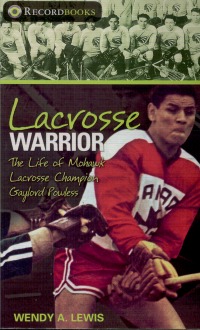| ________________
CM . . .
. Volume XV Number 10. . . .January 9, 2009 
 |
Lacrosse Warrior: The Life of Mohawk Lacrosse Champion Gaylord Powless. (Recordbooks).
Wendy A. Lewis.
Toronto, ON: James Lorimer, 2008.
120 pp., pbk. & hc., $9.95 (pbk), $16.95 (hc.).
ISBN 978-1-55277-001-6 (pbk.), ISBN 978-1-55277-002-3 (hc.).
Subject Headings:
Powless, Gaylord, 1946-2001-Juvenile literature.
Lacrosse players-Canada-Biography-Juvenile literature.
Mohawk Indians-Biography-Juvenile literature.
Grades 5 and up / Ages 10 and up.
Review by Dave Jenkinson.
**½ /4
|
| |
|

excerpt:
Lacrosse was a huge part of Gaylord's life. His dad, uncles, grandparents, and cousins played the sport. He grew up on stories about great lacrosse games and the men who played them.
Gaylord was skilled with a lacrosse stick, even as a toddler. He followed his dad everywhere and played lacrosse every chance he got. When Gaylord was three, his dad earned a spot on the Huntsville team. The family left the reserve and camped near Huntsville so they could see Ross play.
"Gaylord and I used to put on a little show for the fans in between the periods," Ross said. "I'd stand with my back to the net and he'd put a little shift on me and go in for the goal. Beat me every time!"
If the professional game of lacrosse had ever attracted a Canadian television contract like that enjoyed by the National Hockey League, then perhaps the name of Gaylord Powless would be as well-known in this country as is that of Powless's hockey-playing contemporary, Bobby Orr. Because it did not, Gaylord Powless is likely an unknown name to all but serious devotees of lacrosse. Since the game of lacrosse, while Canada's official national summer sport, is not familiar to most Canadians, Lewis wisely begins the book with a chapter entitled "North America's First Team Sport" in which she provides an overview of the history of today's sport of lacrosse which had its roots in Tewaarathon, a game that played an important role in First Nations' culture, especially that of the Mohawk people, the tribal group to which the Powless family belongs. The second chapter, "First There Was Ross," is devoted to Gaylord's father, himself an outstanding lacrosse player and a person who played a significant role in the development of Gaylord's skills.
The remainder of Gaylord's life story is told via 10 more chapters which are essentially presented chronologically. To play at a higher amateur level, Gaylord had to leave his home reserve near Brantford, ON, to play with the Oshawa Green Gaels, a Junior A lacrosse team that enjoyed four consecutive national championships while Gaylord was part of the team. During the championship tournaments, Gaylord was twice named the MVP. Such individual success in amateur hockey would have likely led to a most lucrative professional career, but such was not the case with lacrosse players. Although Gaylord certainly did go on to play lacrosse professionally, the leagues in which he played kept folding, and so he had a very nomadic life. As happened with Bobby Orr, Gaylord's career was shortened by injuries to his knees and back, and, in 1977, at the age of just 30, he retired. However, Gaylord then went on to coach lacrosse for more than two decades. On July 28, 2001, Gaylord succumbed to cancer.
Lewis's main text is augmented by 14 titled boxes which provide brief additional bits of information. For example:
Canada's National Sport: Myth or Fact?
For more than 100 years, most Canadians believed lacrosse was Canada's national sport. But there was not exactly any proof the government did make it officially. In 1994, the government officially named lacrosse Canada's national summer sport. Hockey is the national winter sport.
Fifteen black and white illustrations, almost all them photos and more than half coming from the Powless family collection, are distributed throughout the book. Because of their relatively small size and the quality of the paper on which they were printed, the illustrations are not as effective as they might be. The book concludes with a 38 term lacrosse glossary and three pages of "Acknowledgements" in which Lewis identifies the people and resources which facilitated her writing the book.
Because of the book's brevity, Gaylord does not come "alive" as well as he might have in a longer biography. Since Gaylord had died prior to Lewis's writing this biography, she could only interview relatives and access secondary sources. Consequently, aspects of Gaylord's life, such as the racism he encountered, are only touched upon but not developed. Nonetheless, Lacrosse Warrior is both a fine contribution to the "Recordbooks" series and to the literature about First Nations figures.
Recommended.
Dave Jenkinson, who lives in Winnipeg, MB, is CM's editor.

To comment
on this title or this review, send mail to cm@umanitoba.ca.
Copyright © the Manitoba Library Association. Reproduction for personal
use is permitted only if this copyright notice is maintained. Any
other reproduction is prohibited without permission.
NEXT REVIEW |
TABLE OF CONTENTS FOR THIS ISSUE
- January 9, 2009.
AUTHORS |
TITLES |
MEDIA REVIEWS |
PROFILES |
BACK ISSUES |
SEARCH |
CMARCHIVE |
HOME |
